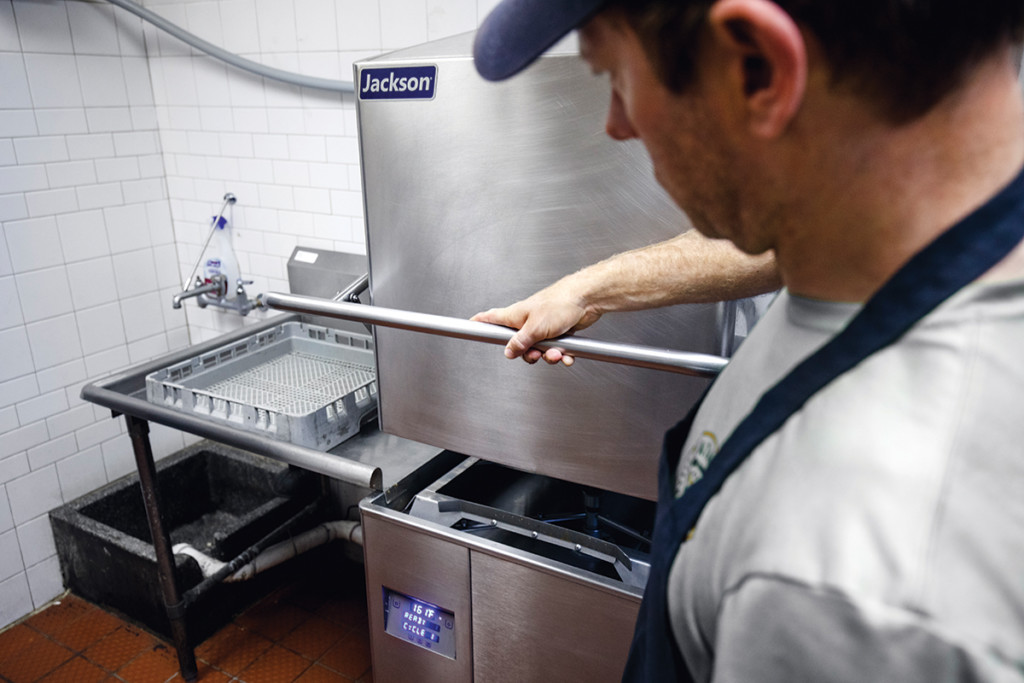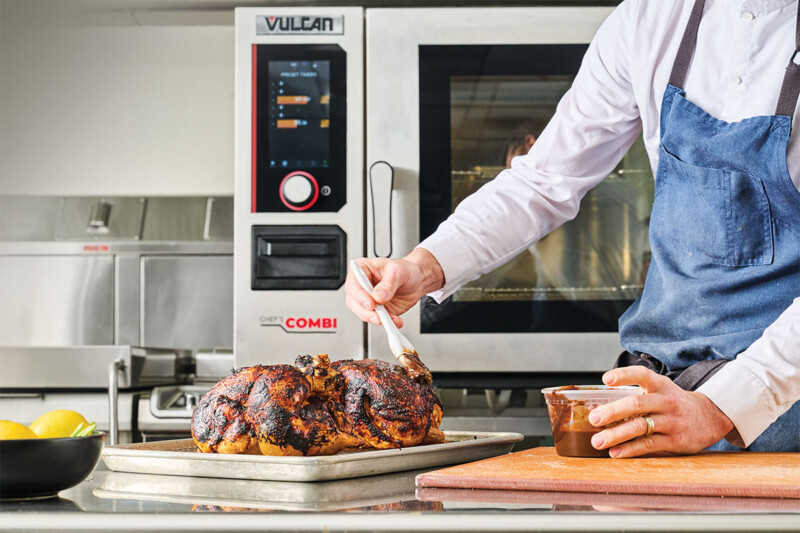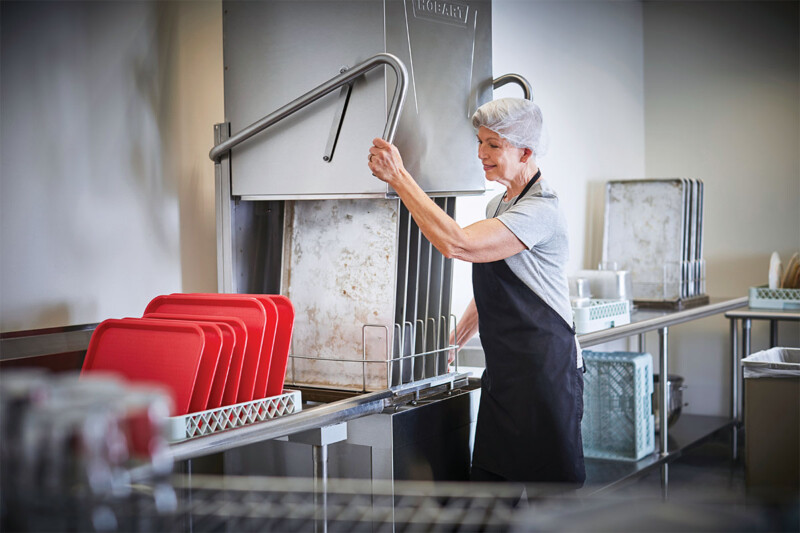
On “Let’s Make A Deal,” Monty Hall would invariably reveal something like a goat behind door #3 before offering a contestant a chance to switch or stay with the door he or she chose.
With high-temperature door-type dishwashers the deal behind virtually every door is a well-made dishwasher capable of knocking out up to 70 racks of dishes per hour. Even Energy Star-rated machines can wash up to 63 racks/hr. Which one you choose largely depends on what you need washed, how much energy and/or water you’re interested in saving, and what kinds of bells and whistles you want.
As electronics become more pervasive in the industry, equipment like door-type washers continues to get smarter. Newer machines have more advanced controls, better self-diagnostics, and are easier to operate thanks to features like touchscreens.
First off, is a door-type machine (also called a hood-type dishwasher) right for your operation? Some models not only wash dishes but pots and pans as well, so they’re ideal in fast-casual operations that serve in disposable ware but have cookware, pans and utensils to keep clean. They can pay for themselves in less than a year versus the labor cost of manually washing pots and pans in a three-compartment sink (though manufacturers also make pot scrubbers for dedicated pot/pan washing). With a maximum capacity of 70 racks per hour—and most energy-efficient machines wash in the range of 50 to 60—they’re best suited to smaller volume operations that use permanent dishware, places with 100 to 150 seats max.
Vent, Less
Relatively compact, door-type machines can squeeze into tight spaces. Though you’ll need areas to set racks for loading and unloading, most models can be configured in the field to operate in a straight-line or corner location. Obviously, you’ll need water lines, a floor drain, and 208V-240V electrical service at a minimum. Oh, and you’ll need a Type II hood to vent steam and heat from the dishroom. Unless…
In the past several years, more manufacturers have added ventless models to their door-type lines. The advantages are two-fold. First, since they don’t need a hood (in many jurisdictions), they’re even more plugand- play than their vented counterparts, and save you the cost of installing a hood/vent. What’s nice is when opening the door at the end of a cycle, your dishroom worker is saved from all those billowing clouds of steamy heat. The bit of magic they work to capture and condense that steamy waste heat helps pre-heat incoming water for the next wash cycle, making them even more energy-efficient. You also save on HVAC, since you no longer need to supply makeup air to the dishroom, or A/C to keep the room cool.
A potential drawback to consider: cycle times of ventless machines are extended, typically by about 30 seconds, for condensation and heat transfer. That lowers the throughput of most ventless models to around 40 to 50 racks/hr. Ventless units are typically taller, too.
Some ventless models require only a cold-water inlet (making initial plumbing costs less expensive). Others still require both cold and hot incoming water—make sure you check. Compare performance specs if you think you’re interested in one over the other.
If you opt to go ventless, consider getting a model with a self-cleaning condensation coil. Employees must periodically clean the coil to prevent mold or mildew build-up; the self-cleaning feature gives them one less thing to do (or forget!) as often.
The Goods
Construction features you should look for include double wall stainless sides and doors (insulated is even better) to save energy and keep heat out of the dishroom; single-piece drawn or stamped (same thing, basically) stainless wash tank preferably with coved corners for easy cleaning (and less likelihood of leaking than welded seams, which NSF won’t approve); and small details like adjustable feet.
Pumps. Wash pumps are sized between ¾ hp and 2 hp, with most makers using about a 1-hp pump. It makes sense that the bigger the pump, the bigger the volume and/or pressure of water sprayed on dishes, but how clean they get also can depend on the design of the spray nozzles and the pattern of the spray arms, too.
In many cases, makers design door-type dishwashers so that once the wash water drains from the spray arms after the wash cycle, the same pump sprays the fresh hot water sanitizing rinse. A few models, however, have separate rinse pumps, one as small as 1/15 hp and another ¾ hp, the same size as the unit’s wash pump. One maker says the separate rinse pumps boost the rinse pressure and guarantee coverage, thereby guaranteeing proper sanitation.
Tank heaters typically run between 3 kW and 7 kW (gas-fired and steam-heated washers are available, too). The former sounds small, but if the washer has a relatively small tank, the 3 kW should be adequate to bring the wash-water temp up to 140°F fairly quickly. A larger wash-water tank can take longer to heat at the start of the day, but may save energy over the long run by providing fresh wash water longer than a smaller tank.
Booster heaters typically are built-in, an advantage since they’re pre-plumbed, wired and sized for the unit. They average in power 9 kW. A few models only offer a booster heater as an option. You’ll need one to get rinse water up to the required 180°F. Make sure yours is designed to handle either the 40° rise (needed if water supply is preheated) or 70° rise (needed if water comes in cold) in temperature you want. A few booster heaters have dual modes to handle both.
Spray arms should have no-clog nozzles, and are easier for employees to clean if they snap out without tools and are interchangeable so it doesn’t matter how employees put them back in.
Scrap filters keep debris out of the wash water and protect the pump. The more accessible they are, the more often employees will remember to check and empty them. Some models use a dual-screen system that first filters out large debris, then a second screen filters finer food particles. An even more aggressive system on a few models is a fairly recent innovation called active filtering. Water flows one direction during the wash cycle, trapping food and debris so the water stays fairly clear. After the wash cycle, the water flows in the opposite direction, flushing scraps out of the screen and down the drain with the waste water.
Height/door clearance. Several makers offer tall versions of their door- or hood-type machines that more easily accommodate full sheet pans, stock pots and other pans. Some regular models may have interior room for most sheet pans, but check door clearances to make sure you can fit them by just sliding the loaded rack in without having to tilt pans them to get them through the opening. Most importantly, measure how high the door will rise when it’s fully open—will it clear the space allotted or is a low ceiling, vent duct or overhead pipe going to block it?
Features To Focus On
Soft start. Most models now have a feature that slowly increases pressure at the beginning of a wash, so glasses or fine china don’t get shock-jostled from the powerful water pressure and break.
Multiple wash cycles. Most models also now offer from two to four different cycles, from about one to six minutes, giving employees the option of a quick wash for normally soiled dishes or a longer cycle for pots and pans or dishes with dried, stuck-on food.
End-of-cycle alarm. This audible feature alerts employees when the wash cycle is finished so they can unload it and start a new load. Virtually all models have an indicator light that lets employees know when the washer is or isn’t running.
Auto-rinse cycle. A few models automatically rinse out the washer interior as part of the unit’s shut-down process.
Auto-clean cycle. This self-cleaning feature rinses the wash chamber up to six times, effectively sanitizing it, then thoroughly drains the machine.
Auto-drain. Most models now automatically drain the wash chamber when employees turn off the machine for the day.
Delime cycle. A nice feature to have is an automatic deliming cycle that removes hard water deposits from the interior of the machine. Some models that don’t have it may at least have a warning light that comes on when it’s time to run scale remover through the washer.
Notes On Safety
Wash-water level regulator. Nearly all machines fill the wash tank automatically. A good additional feature is a wash-water level regulator that keeps the machine filled properly.
Heater/booster tank(s) water regulator. The same goes for the heater tank, and here it’s even more important; otherwise heating elements can burn out.
Over-limit switch. Speaking of which, make sure the heater/booster tank(s) has an over-limit switch that turns off the heating elements if they get too hot.
Final rinse temp guarantee. Many models now have a safety feature that delays completion of a cycle if the final rinse temperature is below 180°F. Once rinse water temperature has reached its set point (as much as 185°F-194°F) the cycle continues.
Door-activated start/stop switch. Another feature that protects employees is a door-activated start/stop switch that turns the machine on as soon as the door or hood is closed, and interrupts the cycle, shutting off the pumps, if the door is opened mid-wash.
Counter-balanced doors/hood. To prevent repetitive stress injuries, the doors/hood should be counter-balanced (usually a spring, not weight) and be guided on low-friction tracks. An ergonomic handle helps, too. Again, measure to ensure the door has vertical clearance.
Leak detection. At least one maker offers leak detection as part of its advanced electronic self-diagnostics; it automatically shuts off the machine if it senses a leak. An early warning can prevent corrosion or even pump burn-out.
Warranties and service areas and options can vary by manufacturer. As always, read the fine print before you buy what’s behind that door.
Support System
One difference you might not notice at first glance is that there are manufacturers whose door-style dishmachine has two front supports at the corners; the hood door slides up on the front and sides but the top stays fixed in place and the back is solid. On other brands, the entire hood raises and lowers, like lifting off the top of a box, and there are no supports in the front corners. Makers of each style will be happy to explain benefits of each style in detail. But in brief, units with supports have a fixed top to which upper wash arms are mounted. Those with entire hoods that raise up mount the top wash arms on a cantilevered support. Makers without supports say lifting the hood leaves the interior wash space free and open for quick rack loading and unloading and easy access for cleaning. Both will claim their designs better disperse the rolling clouds of steam. Supported hoods (without a waste-heat recovery system) will lose steam out the front and sides. Those without the supports (or a waste-heat recovery system) direct steam release toward the back, where it’s open. (All dishroom walls should be water repellent and washable.) For either style, take a careful look at the engineering of the hood’s lift mechanisms, how the handle is attached and lifts and what it’s made of. This is the biggest “moving part” of the machine and it needs to be very durable to open and close every few minutes during wash cycles.
Click to the following page for the Door-Style Dishmachine Gallery.
RELATED CONTENT
- Advertisement -
- Advertisement -
- Advertisement -
TRENDING NOW
- Advertisement -
- Advertisement -
- Advertisement -


